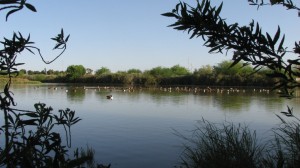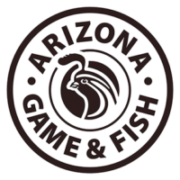Identified: 01/2007
Visiting the IBA: Take US 60 to the Greenfield Road Exit. South on Greenfield and drive south to Guadalupe. The entrance to the parking lot is east of Greenfield on Guadalupe. Winter and spring are the best times to visit.
Riparian Preserve at Gilbert Water Ranch – Arizona Birding Trail
Ownership: Town of Gilbert
Site Description: The Gilbert Riparian Preserves IBA contains two areas: the Water Ranch and Neely Ponds, consisting of riparian, upland, and open water habitats. The wetlands have ponds of varying water levels that also provide roosting and foraging habitat for many waterbird and waterfowl species. The upland habitat is native desert scrub, as well as sedge and grasslands in dry basins.
Birds: Maricopa and Desert Rivers Audubon Society members regularly offer bird walks and beginning birder classes. This IBA is a migration and over-wintering concentration “hot spot” for shorebirds in Arizona and Shorebird diversity is high with 14 species using the wetland basins. Species of special conservation status and interest that use the habitats within this IBA include:
Year-round: American Coot, Pied-billed Grebe, American Kestrel, Double-crested Cormorant, Neotropic Cormorant, Black-crowned Night Heron, Black-bellied Whistling Duck
 Migration: Killdeer, American Avocet, Black-necked Stilt, Greater Yellowlegs, Lesser Yellowlegs, Solitary Sandpiper, Spotted Sandpiper, Western Sandpiper, Least Sandpiper, Short-billed Dowitcher (rare), Long-billed Dowitcher, Stilt Sandpiper (rare), Wilson’s Snipe, and Wilson’s Phalarope.
Migration: Killdeer, American Avocet, Black-necked Stilt, Greater Yellowlegs, Lesser Yellowlegs, Solitary Sandpiper, Spotted Sandpiper, Western Sandpiper, Least Sandpiper, Short-billed Dowitcher (rare), Long-billed Dowitcher, Stilt Sandpiper (rare), Wilson’s Snipe, and Wilson’s Phalarope.
Winter: Canada Goose, Shoveler, American Wigeon, Green-winged Teal, Cinnamon Teal, Blue-winged Teal, Canvasback, Redhead, Pintail, Ring-necked Duck. Mallard, Great Egret, Snowy Egret, Turkey Vulture, Peregrine Falcon, Osprey, and Loggerhead Shrike.
Conservation and Threats: The primary purpose of the site is treatment of waste water for the city of Gilbert. Management of the water system will influence water quality and quantity. Threats to birds using the site include anaerobic water conditions that may facilitate botulism outbreaks, predation by feral cats, and disturbance from human activities-including recreational and facility management. Water management by Town of Gilbert, humane removal of feral cats.
Maps of this Important Bird Area:
Mini Conservation Plan
Complete eBird.org Checklist of birds Reported for Gilbert Riparian Preserves IBA
For an interactive map and habitat and land ownership analysis of this IBA visit the National Audubon IBA Map and select “Arizona” and then select this IBA
Location: East of Phoenix in Gilbert
Counties: Maricopa
Site Status: Identified 01/2007
Ownership: Town of Gilbert
Area: 0.3 square miles, 200 acres
Criteria: D4v: State: shorebirds
D5: State: education site
Site Description: The Riparian Preserves consist of two areas: 110 acres at Site 1 (Water Ranch) consisting of riparian, upland, and open water habitats. Seven recharge basins that replicate wet/dry periods are managed as a part of the City of Gilbert water treatment facility. The Riparian Institute and City of Gilbert host many educational programs at this site that is open to the public. Site 2 (Neely Ponds) is similar, with 11 recharge basins on 72 acres. The adjacent riparian habitat offers an outdoor laboratory environment for educating people about birds and bird habitats.
Public access is restricted because the recharge water at this location has not been disinfected. The site does have viewing ramadas and interpretive signage. The education and research partner is the Riparian Institute http://www.riparianinstitute.org/birding.cfm
Maricopa and Desert Rivers Audubon Society members regularly offer bird walks, beginning birder classes, and participate in bird survey projects at this site.
| Vegetation Description | Hectares |
| CREOSOTEBUSH – BURSAGE (LOWER COLORADO R. VALLEY) COMMUNITIES | 958465.6 |
| SALTBUSH COMMUNITIES | 333372.4 |
Ornithological Summary: These wetlands are positioned within a landscape of widespread urban, agriculture, and desert in the mid-section of the state, thus providing an important oasis for shorebirds in migration. The wetland complexes support significant numbers of shorebirds who find ideal foraging habitat in settling basins of each complex. The wetlands have ponds of varying water levels that also provide roosting and foraging habitat for many waterbird and waterfowl species. The upland habitat is native desert scrub, as well as sedge and grasslands in dry basins.
Shorebird diversity is high with 14 species using the wetland basins over the two sites (Water Ranch 14 species and Neely 11 species). The species in highest concentrations during migration and “winter” periods are the Long-billed Dowitcher, Least Sandpiper, and Black-necked Stilt. American Avocet join these species in lower numbers primarily during the spring migration period. Peak numbers of all shorebird species (on a single day) over the two wetland complexes are 1100 shorebirds during spring and fall migration periods, and near 800 shorebirds during winter. Peregrine Falcons are regularly present during the migration period. Burrowing Owl (a USFWS Bird of Conservation Concern) nest in burrows installed for them at the Water Ranch site. American Kestrel and Loggerhead Shrike regularly use and may nest on site.
IBA program surveys (5/04-4/05) recorded 94 species within this IBA (Water Ranch=59 species, Neely 77 species, Maricopa Audubon IBA Team).All shorebird species includes: Killdeer (Charadrius vociferous), American Avocet (Recurvirostra americana), Black-necked Stilt (Himantopus mexicanus), Greater Yellowlegs (Tringa melanoleuca), Lesser Yellowlegs (Tringa flavipes), Solitary Sandpiper (Tringa solitaria), Spotted Sandpiper (Actitis macularia), Western Sandpiper (Calidris mauri), Least Sandpiper (Calidris minutilla), Short-billed Dowitcher (Limnodromus griseus), Long-billed Dowitcher (Limnodromus scolopaceus), Stilt Sandpiper (Calidris himantopus), Wilson’s Snipe (Gallinago gallinago), Wilson’s Phalarope (Phalaropus tricolor).
Conservation and Threats: The primary purpose of the site is treatment of waste water for the city of Gilbert. Management of the water system will influence water quality and quantity. Threats to birds using the site include anaerobic water conditions that may facilitate botulism outbreaks, predation by feral cats, and disturbance from human activities-including recreational and facility management. Without abatement of threats the site may be a population “sink” for breeding birds.











